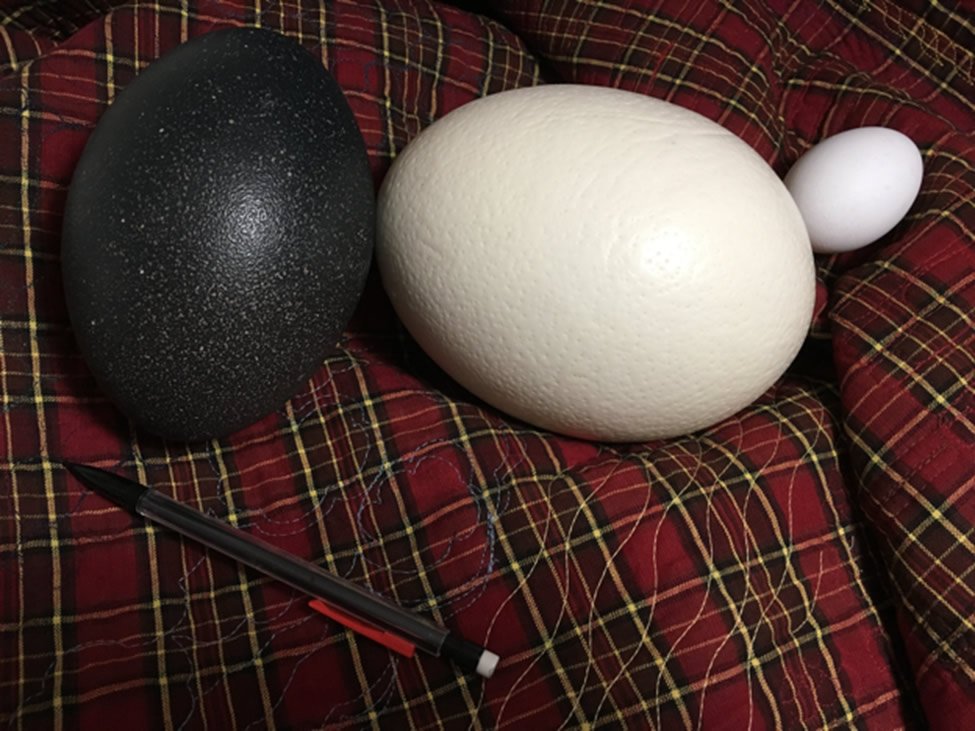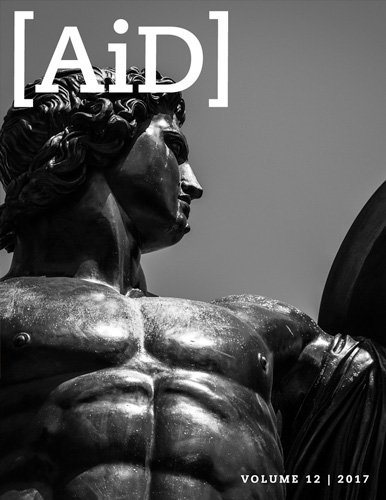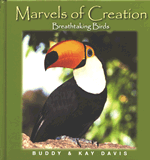
Why “Egg-Shaped” Varies So Much
News to Know
Abstract
Why the chicken must come before the egg, and the shape of things to come. . . .
News Sources
- Science: “Cracking the Mystery of Egg Shape”
- Science: “A Surprisingly Simple Explanation for the Shape of Bird Eggs”
At-a-Glance
- Bird eggs come in a wide variety of designer shapes.
- Bird egg shape is determined before the shell is applied.
- Scientists wonder why bird egg shapes vary so much.
- Bird egg shape seems to be related, in part, to how streamlined the adult bird’s body is.
Stealing birds’ eggs is “now deeply unfashionable and rightly illegal,” as the author of “The Most Perfect Thing, Explained” in Science reminds us.1 However, for almost a century it was quite the hobby, especially for self-styled naturalists who roamed the world raiding concealed nests. Why was that? Largely because bird eggs come in so many colors, patterns, and—especially—shapes. Some are almost spherical while many are elongated to varying degrees. Some are symmetrical, but many are pointier on one end. The great variety of shape in bird eggs is also found in the fossil record.
Just what advantage a particular egg shape offers has long been the subject of scientific speculation. Depending on a scientist’s worldview, this question may be approached either with an eye to understanding why God the Master Designer created eggs with so many variations, or with the goal of explaining why different egg shapes evolved through natural processes.
Ornithology textbooks contain many scholarly pronouncements on the subject. For instance, some suggest that pointy eggs are less likely to roll off high ledges, or that certain shapes allow more eggs to be crammed together in a nest, or that high calcium consumers can spare the minerals to build more shell. (Elliptical eggs require more shell surface than spherical ones to provide the same internal volume.)

The emu egg (left) is more elongated than the ostrich egg in the center. And the chicken egg on the right is more asymmetrical than either. The diversity of bird egg shapes spans a wide range from spherical to elliptical with many degrees of asymmetry. Why? Image by author.
Room in the Egg
Changing the shape of an egg changes how roomy it is. After all, the purpose of a bird’s egg (or any shelled egg for that matter) is to provide a safe place for a young creature to develop and grow until it is mature enough to survive in the world. Spherical eggs offer the greatest volume, for any given amount of shell surface, for a baby bird to develop. But room to grow isn’t the only important egg feature. Egg shells typically have lots of pores to admit fresh air, creating a pocket of breathable air between the membranes inside the shell. Asymmetrical eggs allow a greater space on the blunt end to concentrate aeration pores over this pocket, improving the air supply for the developing bird inside. So could it perhaps be the need for a really big bubble of freshening air to supply oxygen for rapid growth that drove some more precocious birds to produce eggs of varied shapes?
Princeton University’s Mary Caswell Stoddard, an evolutionary biologist, wanted to crack the mystery of myriad egg shapes. She and her colleagues, who have now published their surprising findings in Science magazine, first examined the typical textbook explanations. Turns out that, though some describe egg characteristics or genuine advantages, none are consistent with the facts across a wide range of birds. They therefore fail to explain what drives eggs to take certain shapes.
The Raw Egg Data
The raw material for Stoddard’s study was a museum collection of 49,175 eggs. These came from around 1,400 species belonging to 35 living and 2 extinct orders of birds. If you are a bird aficionado, you may think there are only 23 orders of birds. Or perhaps 28. Or maybe 46. But bird classification is a contentious and changing topic, and the number of orders has been revised based in part on DNA data. Suffice to say the study group of pilfered eggs came from a wide variety of birds, and don’t stress about how many orders. What it did not include was dinosaur eggs. But we’ll get to that later.
The researchers wrote a computer program—Eggxtractor—to analyze all these eggs. Eggxtractor measured and categorized each egg’s degree of asymmetry—how pointy it is on one end—and its ellipticity—how elongated it is. The researchers also evaluated the internal volume of each egg—how much room there is inside for a chick to develop. Then they grouped the eggs according to what category of bird produced them, hoping to see if lineages in the bird family tree might explain the shapes. Turns out, it is not so much lineage as lifestyle that explains the utility of many egg variations. Egg shape, it seems, is strongly related to how much flying a bird is designed to do.
The Shape of Eggs to Come
So what gives a bird egg its shape? Contrary to what you might think, the shape of an egg is not determined by the shell. Eggs are not just molded calcium casts of the momma bird’s internal egg maker. The shell membranes under the shell determine the shape before the shell is applied.
If you are unconvinced that the shell is not the source of the shape, try this simple experiment.
If you are unconvinced that the shell is not the source of the shape, try this simple experiment. Soak an egg—one you bought at the supermarket, not one you stole from a wild bird’s nest—in white vinegar until the shell dissolves away. The rubbery egg remaining is still shaped like the original egg. (By the way, this is a great way to convince your kids to floss and brush, lest the acids produced by nasty bacteria on their teeth eat away at the calcium compounds protecting their teeth.)
Before we see how a bird’s lifestyle and associated aerodynamic body shape influence the shape of its eggs, let’s consider how a bird egg is manufactured. Bird eggs form inside the mother bird’s long oviduct. The oviduct is the tube into which an ovary initially sends some yolk and an ovum. Incidentally, a bird only has one ovary and one oviduct, not a pair of them like most other animals.
After a bit of yolk is released from an ovarian follicle, fertilization may occur if sperm are stored in the oviduct. Then thick egg white (albumin) is layered on. Ridges—like rifling in a rifle barrel—then spin the egg as it travels through the oviduct, twisting the protein molecules in the albumin on each end of the egg. These twisted ropes of protein form chalazae, suspending the yolk in the center of the egg. Next a two-layered shell membrane forms loosely around this unit. One end of each chalazae is stuck to the inner membrane, and that’s going to become important.
Further along the oviduct, a watery albumin diffuses into the egg, plumping it out to the proper shape defined by the membranes. Mineralized shell—expanding crystals formed from a concentrated calcium carbonate solution—is added to this pre-established shape farther down the oviduct. Pores in the shell are the spaces in between these crystals. The shell material is covered by a gas-permeable thin layer of protective cuticle. Then the egg flips around and is ready to be laid.
Birds are warm-blooded. Once a bird’s egg is laid into the cooler environment outside the mother’s body, contraction of the material inside the egg creates an air space between the shell membranes because the chalazae tugs on the inner membrane. This air space is later punctured by the developing chick so that it can begin to breathe before hatching. (Have a look at this process in “The Virtual Chicken,” an excellent production by Auburn University’s Poultry Science Department.)
A Pressured Environment
An egg under a nesting bird is subjected to a great deal of pressure. And for all their variety, bird egg shapes have one thing in common—they employ an arch. A shell’s arched shape—like an architectural arch—is optimized to support the weight of the mother bird and the pressure from its neighboring eggs. This thin shell of a cubic or trapezoidal egg, having sharp angles and lacking the arched shape, could not long withstand this sort of pressure. But there are a lot of egg shapes that work quite nicely. Round or elliptical, pointy or not—there is an almost infinite variety of possibilities between the extremes, and the birds of the world seem to have exploited almost all the possibilities in the egg shapes they lay.
But there is another sort of pressure that affects an egg—the pressure on it before it ever gets its shell. As Stoddard’s group tried to puzzle out the egg mystery, they realized that the answer probably lay in the place eggs got their shape in the first place: the oviduct where the shell membranes were applied. As the incipient egg is formed, it is subject to external pressure from the walls of the oviduct—pressure that squeezes around its girth and pressure on its long axis that propels it through the tubular organ. These external pressures compete with the internal pressure of the egg’s contents—the yolk, the albumin, the water that plumps it up, and the tiny chick.
Membrane materials can vary in the thickness, density, and orientation of their fibers. These membrane characteristics determine how resistant an egg is to the pressures inside the oviduct. The interplay of the developing membranes’ properties and the oviduct’s squeezing produces the resulting egg’s shape, before the shell is ever applied. Stoddard’s group noted that only one variation—a hot air balloon’s shape—are just not seen, happily for the bird charged with laying them. This is probably a poor production design because the membrane properties of the advancing egg would have to change too rapidly to make the shape change so drastically from one end to the other.
So what might make the oviduct of one bird differ in pressures from another bird’s? How about the shape of the body? Might a more streamlined bird’s body put more pressure on a developing egg and impose a more elongated or asymmetrical shape? However this might be accomplished, the first thing to find out was whether streamlining is associated with egg shape. The researchers hypothesized that birds with the most aerodynamic wing shape—a feature often associated with a streamlined body—should be associated with more elongated or asymmetrical eggs. They figured that a more streamlined bird would have a narrower pelvis, and thus need a much narrower egg. And the only way to fit a chick into an incredibly skinny egg is to make the egg longer, hence more elliptical or asymmetrical.
The bulk of the egg-and-wing data confirmed their hypothesis. Migratory birds and birds that spend most of their time in the air—like sandpipers and swifts and hummingbirds—had highly asymmetrical or elliptical eggs. Birds that stick close to home—like puffbirds and trogons and owls—have more spherical eggs. So does the flightless ostrich. The flightless penguin’s egg leans far more toward the nonspherical end of the spectrum, but penguins, after all, are streamlined for “flying” through water. The emu’s egg is fairly elongated however, and it does not fly at all. Clearly therefore scientists do not eggs-actly have all the answers yet, but Stoddard’s group has started to unravel the egg mystery and laid to rest a number of far more insufficient explanations.
Dinosaur Tales
Does anything about egg shapes link birds to dinosaurs, their supposed evolutionary ancestors?
So let’s have a quick look, before we close, at the elephant in the room. Does anything about egg shapes link birds to dinosaurs, their supposed evolutionary ancestors? Stoddard’s team thinks so. They write that elliptical eggs evolved early among crocodilian reptiles because crocodiles have to pack pretty big babies into eggs narrow enough to fit through their anatomical openings if the babies are to be born able to fend for themselves. And they note that some theropod dinosaurs—including but not limited to the maniraptorans from which birds supposedly evolved—had asymmetrical eggs.
Addressing the fact that birds have only one ovary and oviduct, while reptiles and therefore presumably dinosaurs had two, they simply assume that both egg asymmetry and the loss of a functional ovary were flight adaptations and must have evolved about the same time.2 However, nothing in the authors’ discoveries support a dinosaur-bird link. The authors are simply assuming that an evolutionary link exists and trying to fit the facts about birds—that they have a unique reproductive tract design—and eggs—that some birds and some dinosaurs lay asymmetrical ones—into their unfounded evolutionary presupposition.
Designer Eggs
Stoddard’s study is for the most part a fine example of observational science. The team analyzed many observations, looked for patterns, critically examined commonly held ideas about why certain egg shapes are desirable, hypothesized a new one, and evaluated their hypothesis in light of observed data. But the authors were over easy on the evolutionary assumptions.
What Stoddard’s study does not demonstrate is any way that birds or eggs could have evolved. The survival value of a certain trait such as egg shape suited to body shape that is in turn suited to a particular lifestyle may exert selection pressure on populations, and thus influence the speciation of birds. But nothing about that process explains how eggs, shells, shapes, or birds could have evolved in the first place. Discovering the advantages of particular designs does not reveal how the genetic information to produce those designs came to exist in the first place.
There are still many questions to answer. Why one super-flier’s eggs are more symmetrically elliptical, and another’s are just pointy, for instance. And why the more spherical shape seems to be the default shape, given that the egg is formed as it traverses a tubular structure. But Stoddard’s work has made a good start at solving the puzzle of egg shapes. The work also demonstrates the wisdom of the Designer of birds and their eggs, the Creator God of the Bible, who created the bird kinds on the fifth day of the world’s existence, about 6,000 years ago. All the species of birds we have today, and all the extinct kinds of birds, are descended from those original created kinds of birds, and the adaptive variations among them have developed within the genetic information he created with those original birds. That even the shape of a bird’s egg is suited to its body and lifestyle is a testament to his wisdom.
Further Reading
- Experiment: Walking on Eggshells
- The Intricacies of Flight in the Natural World
- Dino-Mom and Egg
- Which Came First: Egg-Laying or Live Bearing Mammals?
- Seabird Study Said to Solve the Evolutionary Mystery of Flightlessness
For More Information: Get Answers
Remember, if you see a news story that might merit some attention, let us know about it! (Note: if the story originates from the Associated Press, FOX News, MSNBC, the New York Times, or another major national media outlet, we will most likely have already heard about it.) And thanks to all of our readers who have submitted great news tips to us. If you didn’t catch all the latest News to Know, why not take a look to see what you’ve missed?
(Please note that links will take you directly to the source. Answers in Genesis is not responsible for content on the websites to which we refer. For more information, please see our Privacy Policy.)
Footnotes
- Claire N. Spottiswoode, “The Most Perfect Thing, Explained,” Science 356, no. 6344 (June 23, 2017):1235, doi:10.1126/science.aaj2517.
- They write, “The loss of a functional ovary and oviduct likely occurred near the maniraptoran-avian transition and may be an innovation unique to birds. Thus, egg asymmetry and the loss of a functional ovary appeared around the same time as, and are perhaps closely linked to, the emergence of powered flight.” Mary Caswell Stoddard et al., “Avian Egg Shape: Form, Function, and Evolution,” Science 356, no. 6344 (June 23, 2017): 1253, doi:10.1126/science.aaj1945.
Recommended Resources

Answers in Genesis is an apologetics ministry, dedicated to helping Christians defend their faith and proclaim the good news of Jesus Christ.
- Customer Service 800.778.3390
- © 2024 Answers in Genesis


